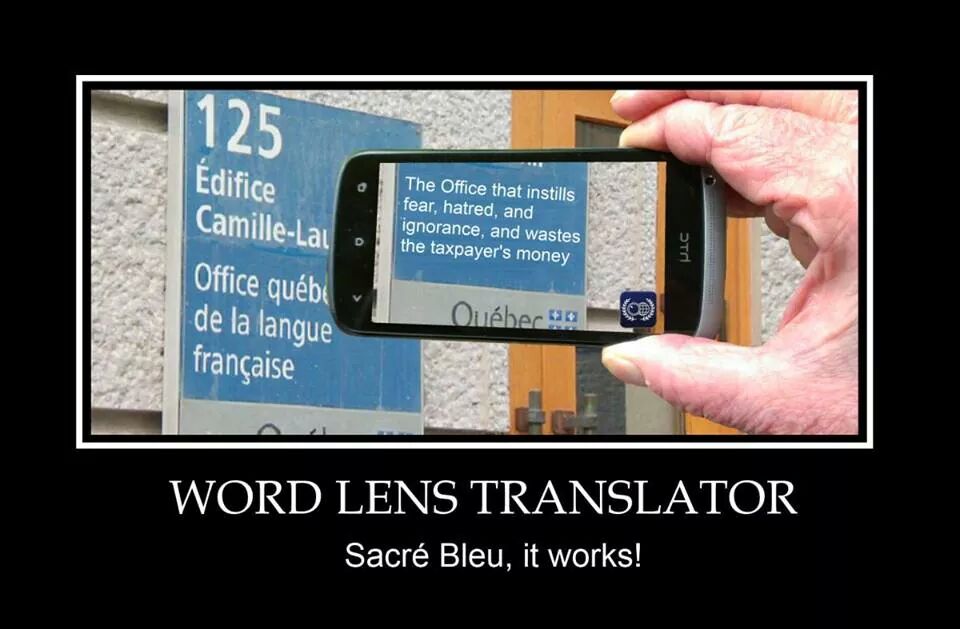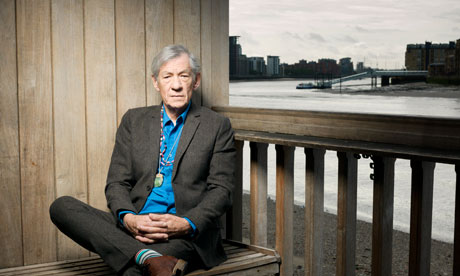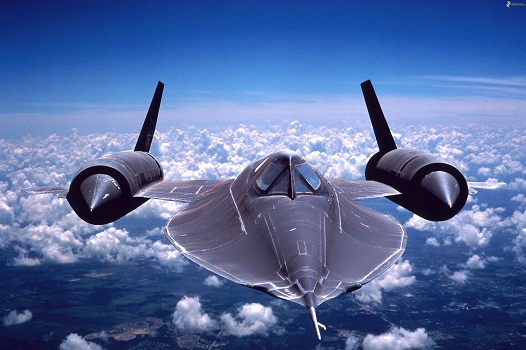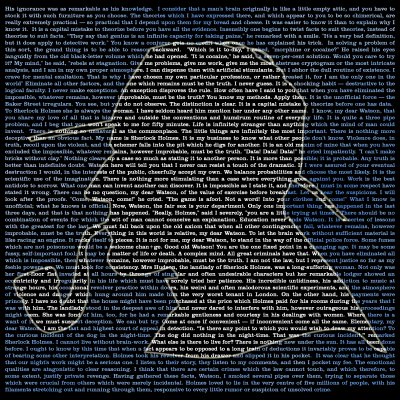
Tag: geek
Letting my inner artist out to play
Le augmented reality, hon! hon! hon!

Non-Imaginary Excrement

Phishing scams

Don’t ever do it. Ever. Just… no.
Digital distractions
Oh god, this is so me!

Vintage social networking
Ian McKellen and Laura Linney to explore Sherlock’s twilight years

Oooooh! Now he gets to wear a t-shirt that says “I’m Gandalf, Magneto and Sherlock! Deal with it!” :D
In recent years the sleuthing of Sherlock Holmes has been depicted as ass-kicking and wisecracking in Guy Ritchie’s movies, and as drily witty and cerebrally thrilling in the BBC TV series starring Benedict Cumberbatch. But now a new, quieter side to Arthur Conan Doyle’s detective is set to reach the screen: his old age, after he retired to keep bees.
Ian McKellen is set to play Holmes in A Slight Trick of the Mind, adapted from the 2005 novel by Mitch Cullin which imagines Holmes’s twilight years, alluded to in Doyle’s novels. The film will depict him working on his final case aged 63, and also retired in Sussex aged 91, mentally frail and obsessed with the unsolved crime. Laura Linney will play his housekeeper, Mrs Munro, whose son Holmes has a fatherly attachment to.
The film will be directed by Bill Condon, who has worked on acclaimed films with each of the actors before: the Oscar-winning Gods and Monsters with McKellen, and his Alfred Kinsey biopic with Linney. “It’s a really great mystery about who Sherlock Holmes is, but it’s also a lovely, delicate movie about what happens as you get older,” Condon told Entertainment Weekly. “I’m looking forward to the combined talent, skills, and smarts [of Linney and McKellen]. Both of them are incredibly detail-oriented and do an amazing amount of work before they get to set, and then they dive off the board and become their characters.”
Memories from the greatest airplane ever built

Brian Shul, “Sled Driver: Flying the World’s Fastest Jet”
So it was with great surprise, when at the end of one of my presentations, someone asked, “what was the slowest you ever flew the Blackbird?” This was a first. After giving it some thought, I was reminded of a story that I had never shared before, and relayed the following.
I was flying the SR-71 out of RAF Mildenhall, England , with my back-seater, Walt Watson; we were returning from a mission over Europe and the Iron Curtain when we received a radio transmission from home base. As we scooted across Denmark in three minutes, we learned that a small RAF base in the English countryside had requested an SR-71 fly-past. The air cadet commander there was a former Blackbird pilot, and thought it would be a motivating moment for the young lads to see the mighty SR-71 perform a low approach. No problem, we were happy to do it. After a quick aerial refueling over the North Sea , we proceeded to find the small airfield.
Walter had a myriad of sophisticated navigation equipment in the back seat, and began to vector me toward the field. Descending to subsonic speeds, we found ourselves over a densely wooded area in a slight haze. Like most former WWII British airfields, the one we were looking for had a small tower and little surrounding infrastructure. Walter told me we were close and that I should be able to see the field, but I saw nothing.
Nothing but trees as far as I could see in the haze. We got a little lower, and I pulled the throttles back from 325 knots we were at. With the gear up, anything under 275 was just uncomfortable. Walt said we were practically over the field—yet; there was nothing in my windscreen. I banked the jet and started a gentle circling maneuver in hopes of picking up anything that looked like a field. Meanwhile, below, the cadet commander had taken the cadets up on the catwalk of the tower in order to get a prime view of the fly-past. It was a quiet, still day with no wind and partial gray overcast.
Walter continued to give me indications that the field should be below us but in the overcast and haze, I couldn’t see it.. The longer we continued to peer out the window and circle, the slower we got. With our power back, the awaiting cadets heard nothing. I must have had good instructors in my flying career, as something told me I better cross-check the gauges. As I noticed the airspeed indicator slide below 160 knots, my heart stopped and my adrenalin-filled left hand pushed two throttles full forward. At this point we weren’t really flying, but were falling in a slight bank. Just at the moment that both afterburners lit with a thunderous roar of flame (and what a joyous feeling that was) the aircraft fell into full view of the shocked observers on the tower
Shattering the still quiet of that morning, they now had 107 feet of fire-breathing titanium in their face as the plane leveled and accelerated, in full burner, on the tower side of the infield, closer than expected, maintaining what could only be described as some sort of ultimate knife-edge pass. Quickly reaching the field boundary, we proceeded back to Mildenhall without incident. We didn’t say a word for those next 14 minutes.
After landing, our commander greeted us, and we were both certain he was reaching for our wings. Instead, he heartily shook our hands and said the commander had told him it was the greatest SR-71 fly-past he had ever seen, especially how we had surprised them with such a precise maneuver that could only be described as breathtaking. He said that some of the cadet’s hats were blown off and the sight of the plan form of the plane in full afterburner dropping right in front of them was unbelievable. Walt and I both understood the concept of “breathtaking” very well that morning, and sheepishly replied that they were just excited to see our low approach.
As we retired to the equipment room to change from space suits to flight suits, we just sat there-we hadn’t spoken a word since “the pass.” Finally, Walter looked at me and said, “One hundred fifty-six knots. What did you see?” Trying to find my voice, I stammered, “One hundred fifty-two.”
We sat in silence for a moment. Then Walt said, “Don’t ever do that to me again!” And I never did.
A year later, Walter and I were having lunch in the Mildenhall Officer’s club, and overheard an officer talking to some cadets about an SR-71 fly-past that he had seen one day. Of course, by now the story included kids falling off the tower and screaming as the heat of the jet singed their eyebrows. Noticing our HABU patches, as we stood there with lunch trays in our hands, he asked us to verify to the cadets that such a thing had occurred. Walt just shook his head and said, “It was probably just a routine low approach; they’re pretty impressive in that plane.” Impressive indeed.
And another good quote:
We listened as the shaky voice of a lone Cessna pilot who asked Center for a read-out of his ground speed. Center replied: “November Charlie 175, I’m showing you at ninety knots on the ground.” Now the thing to understand about Center controllers, was that whether they were talking to a rookie pilot in a Cessna, or to Air Force One, they always spoke in the exact same, calm, deep, professional tone that made one feel important. I referred to it as the “Houston Center voice.” I have always felt that after years of seeing documentaries on this country’s space program and listening to the calm and distinct voice of the Houston controllers, that all other controllers since then wanted to sound like that and that they basically did. And it didn’t matter what sector of the country we would be flying in, it always seemed like the same guy was talking. Over the years that tone of voice had become somewhat of a comforting sound to pilots everywhere. Conversely, over the years, pilots always wanted to ensure that, when transmitting, they sounded like Chuck Yeager, or at least like John Wayne. Better to die than sound bad on the radios.
Just moments after the Cessna’s inquiry, a Twin Beech piped up on frequency, in a rather superior tone, asking for his ground speed in Beech. “I have you at one hundred and twenty-five knots of ground speed.” Boy, I thought, the Beechcraft really must think he is dazzling his Cessna brethren.
Then out of the blue, a navy F-18 pilot out of NAS Lemoore came up on frequency. You knew right away it was a Navy jock because he sounded very cool on the radios. “Center, Dusty 52 ground speed check.” Before Center could reply, I’m thinking to myself, hey, Dusty 52 has a ground speed indicator in that million-dollar cockpit, so why is he asking Center for a read-out? Then I got it, ol’ Dusty here is making sure that every bug smasher from Mount Whitney to the Mojave knows what true speed is. He’s the fastest dude in the valley today, and he just wants everyone to know how much fun he is having in his new Hornet. And the reply, always with that same, calm, voice, with more distinct alliteration than emotion: “Dusty 52, Center, we have you at 620 on the ground.” And I thought to myself, is this a ripe situation, or what? As my hand instinctively reached for the mic button, I had to remind myself that Walt was in control of the radios. Still, I thought, it must be done—in mere seconds we’ll be out of the sector and the opportunity will be lost. That Hornet must die, and die now. I thought about all of our Sim training and how important it was that we developed well as a crew and knew that to jump in on the radios now would destroy the integrity of all that we had worked toward becoming. I was torn.
Somewhere, 13 miles above Arizona, there was a pilot screaming inside his space helmet. Then, I heard it—the click of the mic button from the back seat. That was the very moment that I knew Walter and I had become a crew. Very professionally, and with no emotion, Walter spoke: “Los Angeles Center, Aspen 20, can you give us a ground speed check?” There was no hesitation, and the replay came as if was an everyday request.
“Aspen 20, I show you at one thousand eight hundred and forty-two knots, across the ground.” I think it was the forty-two knots that I liked the best, so accurate and proud was Center to deliver that information without hesitation, and you just knew he was smiling. But the precise point at which I knew that Walt and I were going to be really good friends for a long time was when he keyed the mic once again to say, in his most fighter-pilot-like voice: “Ah, Center, much thanks, we’re showing closer to nineteen hundred on the money.”
For a moment Walter was a god. And we finally heard a little crack in the armor of the Houston Center voice, when L.A. came back with, “Roger that Aspen. Your equipment is probably more accurate than ours. You boys have a good one.” It all had lasted for just moments, but in that short, memorable sprint across the southwest, the Navy had been flamed, all mortal airplanes on freq were forced to bow before the King of Speed, and more importantly, Walter and I had crossed the threshold of being a crew. A fine day’s work. We never heard another transmission on that frequency all the way to the coast. For just one day, it truly was fun being the fastest guys out there.
Time for bed!

Been there, do that fairly regularly.



